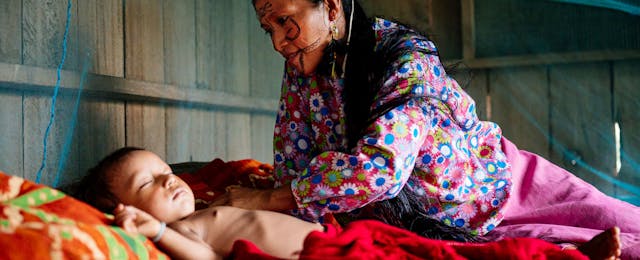
Malaria disproportionately impacts pregnant women and children under five, putting their lives, education, and future potential at risk. Around the world, malaria in pregnancy contributes 10,000 maternal deaths each year and is also responsible for up to 200,000 newborn deaths.
In Ecuador, the Ministry of Health working to strengthen and expand health coverage across the country, particularly in rural and hard-to-reach areas, improving access to quick malaria diagnosis and treatment to significantly reduce the malaria burden on women and children. Ending malaria, a deadly yet entirely preventable and treatable disease, offers one of the most significant opportunities to improve maternal and child survival in Ecuador and around the world.
Olga Pitiur works as a midwife in Wachirpas, Ecuador in collaboration with the health center. Olga has suffered from malaria multiple times and has attended to mothers with malaria symptoms such as fever, vomiting, and overall pain. She told us that her grandparents would use the Cinchona tree’s bark (from which quinine is derived) to treat malaria, but that the concoction was too dangerous for pregnant women to use. For her, it is important to work to eliminate malaria from Ecuador.
“I help mothers have healthy babies. Being malaria-free would give the pregnant women I work with the chance to give birth safely and live a healthy life in our community.
Every time I see a pregnant woman, I encourage her to sleep under a mosquito bed net and I refer her to the health center so she can get screened and treated if needed.
I always hope that one day, those children will become nurses or doctors and will lead and take care of our community.”
Ecuador, a historically malaria-endemic country in the Amazon, represents a regional success story: malaria elimination efforts led to a reduction of reported malaria cases from 800,000 in 2000 to just 241 in 2014 and malaria mortality dropping to zero.
But we know that progress can be fragile. Despite nationwide elimination efforts, malaria incidence has been increasing recently with cases reaching 1,843 in 2019. Greater mobility of people at the border with Colombia and Peru, as well as climate events, including El Niño, which increases temperature and precipitation, add to the country’s challenges. This puts vulnerable populations like women and children at risk.
Help us protect mothers and children and give in honor of a mom in your life this Mother’s Day.
Click here to take a trip to the frontlines of malaria elimination in Ecuador and learn more about these communities at risk.